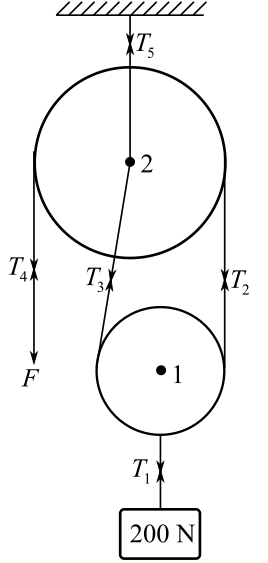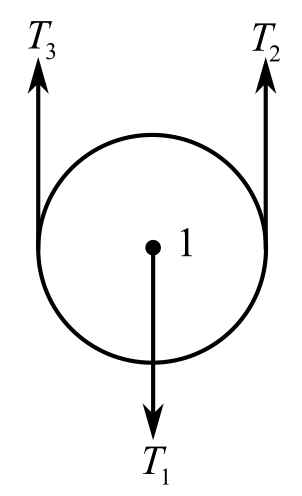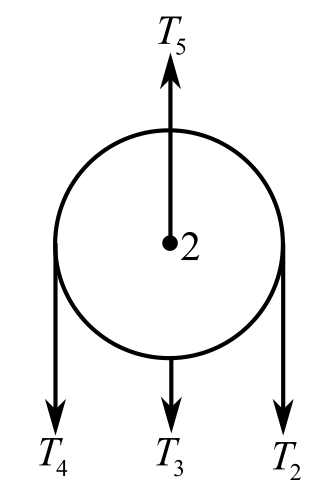
Concept explainers
The load in Fig. 4-7 is hanging at rest. Take the ropes to all be vertical and the pulleys to be weightless and frictionless. (a) How many segments of rope support the combination of the lower pulley and load? (b) What is the downward force on the lowest pulley (the “floating” one)? (c) What must be the total upward force exerted on the floating pulley by the two lengths of rope? (d) What is the upward force exerted on the floating pulley by each length of rope supporting it? (e) What is the tension in the rope wound around the two pulleys? (f) How much force is the man exerting? (g) What is the net downward force acting on the uppermost pulley? (h) How much force acts downward on the hook in the ceiling?
(a)
The segments of the rope that support the combination of the lower pulley given inFigure
Answer to Problem 16SP
Solution:
Explanation of Solution
Given data:
The weight of the hanging block is
The load is hanging on rest, so there will be no acceleration.
Formula used:
Write the expression for the first condition of the force’s equilibrium:
Here,
Explanation:
Draw the free body diagram of the system:

In the above diagram, point
Since the same rope is passing over theupper pulleyand lower pulley, the magnitude of tensionthroughout the rope should be same. Therefore,
Refer to the above diagram and consider the pulley 1. In this case,
Consider the upward forces as positive and the downward forces as negative. Therefore,
Substitute
Conclusion:
Therefore, two segments of the rope support the combination of the lower pulley and load.
(b)
The magnitude of the downward force applied to the lowest pulleyin the Figure
Answer to Problem 16SP
Solution:
Explanation of Solution
Given data:
The load is
The load is hanging on rest, so there will be no acceleration.
Formula used:
Write the expression for the first condition of the force’s equilibrium:
Here,
Explanation:
Draw the free body diagram when

Recall the expression for the first condition of the force’s equilibrium:
Consider the direction of the upward forces is positive and the direction of the downward forces is negative. Therefore,
Substitute
The tension forces of 200 N, acting in the rope, pule the load in upward direction and weight of the
Conclusion:
Therefore, the magnitude of the downward force on the lowest pulley is
(c)
The magnitude of the total upward force exertedon the floating pulley by the two lengths of ropein the Figure
Answer to Problem 16SP
Solution:
Explanation of Solution
Given data:
The load is
The load is hanging on rest, so there will be no acceleration.
Formula used:
Write the expression for the first condition of the force’s equilibrium:
Here,
Explanation:
Draw the free body diagram of the lowermost pulley:

Recall the expression for the first condition of the force equilibrium:
Consider the direction of the upward forces is positive and the direction of the downward forces is negative. Hence,
Substitute
Conclusion:
The magnitude of the total upward force applied on the pulley by the two lengths of the rope is
(d)
The magnitude of the upward force applied on the floating pulley by each length of rope supporting the pulleyin the figure
Answer to Problem 16SP
Solution:
Explanation of Solution
Given data:
The weight of the person is
The load is hanging on rest, so there will be no acceleration.
Formula used:
Write the expression for the first condition of the force’s equilibrium:
Here,
Explanation:
Draw the free body diagram of the lowermost pulley:

Recall the expression for the first condition of the force’s equilibrium:
Consider the direction of the upward forces is positive and the direction of the downward forces is negative. Hence,
Substitute
Conclusion:
The magnitude of the upward force applied on the floating pulley by each length of the rope is
(e)
The magnitude of the tensionin the rope wound around the two pulleysin the Figure
Answer to Problem 16SP
Solution:
Explanation of Solution
Given data:
The load is
The load is hanging on rest, so there will be no acceleration.
Formula used:
Write the expression for the first condition of the force’s equilibrium:
Here,
Explanation:
Refer to the diagram drawn in the subpart (a). A single rope is wounded on the both the polis. So, the magnitude of tension should be same throughout the rope. Therefore,
Substitute
Conclusion:
The magnitude of the tension in the rope wound around the pulley is
(f)
The maximum force applied by the man to pull the ropein the Figure
Answer to Problem 16SP
Solution:
Explanation of Solution
Given data:
The load is
The load is hanging on rest, so there will be no acceleration.
Formula used:
Write the expression for the first condition of the force’s equilibrium:
Here,
Explanation:
Draw the free body diagram of the unwound rope, which is in the right side of the upper pulley, when a man exerts a force F to pull the rope.

To observed the schematic diagram of the problem,
The force
Recall the expression for the first condition of the force’s equilibrium:
Consider the direction of the upward forces is positive and the direction of the downward forces is negative. Hence,
Substitute
Conclusion:
The magnitude of the maximum force applied by the man is
(g)
The magnitude of the net downward force acting on the uppermost pulleyin the Figure
Answer to Problem 16SP
Solution:
Explanation of Solution
Given data:
The load is
The load is hanging on rest, so there will be no acceleration.
Formula used:
Write the expression for the first condition of the force’s equilibrium:
Here,
Explanation:
Draw the free body diagram of the upper pulley:

Recall the expression for the first condition of the force’s equilibrium:
Consider the direction of the upward forces is positive and the direction of the downward forces is negative. Hence,
Substitute
The net downward force acting on the uppermost pulleyhas the same magnitude as the tension of the rope, which is
Conclusion:
Therefore, the total downward force acting on the upper pulley is
(h)
The maximum force that is acting downward on the hook in the ceilingin the Figure
Answer to Problem 16SP
Solution:
Explanation of Solution
Given data:
The load is
The load is hanging on rest, so there will be no acceleration.
Formula used:
Write the expression for the first condition of the force’s equilibrium:
Here,
Explanation:
Refer to the schematic diagram of the problem from the subpart (a).
The maximum force applied downward on the hook in the ceiling is equal to the same magnitude of the tension
Conclusion:
Therefore, themaximum force applied downward on the hook in the ceilingis
Want to see more full solutions like this?
Chapter 4 Solutions
College Physics
Additional Science Textbook Solutions
Essential University Physics: Volume 1 (3rd Edition)
Fundamentals Of Thermodynamics
Conceptual Physical Science (6th Edition)
Physics for Scientists and Engineers
- For the woman being pulled forward on the toboggan in Figure 4.33, is the magnitude of the normal force exerted by the ground on the toboggan (a) equal to the total weight of the woman plus the toboggan, (b) greater than the total weight, (c) less than the total weight, or (d) possibly greater than or less than the total weight, depending on the size of the weight relative to the tension in the rope?arrow_forwardA boxweighing 150 lb is moved across a horizontal floor by dragging it means of a rope attached to the front end. If the rope makesan angle of 30 ̊with the floor and if the coefficient of friction between box and floor is 0.4, find the force exerted by the man pulling the rope.arrow_forwardA body of weight 450 N is pulled up an inclined plane by a force of 300N . The inclination of the plane is 30° to the horizontal and the force is applied parallel to the plane. Determine the coefficient of frictionarrow_forward
- In about 1915, Henry Sincosky of Philadelphia suspended himself from a rafter by gripping the rafter with the thumb of each hand on one side and the fingers on the opposite side. Sincosky’s mass was 79 kg. If the coefficient of static friction between hand and rafter was 0.70, what was the least magnitude of the normal force on the rafter from each thumb or opposite fingers? (After suspending himself, Sincosky chinned himself on the rafter and then moved hand-over-hand along the rafter. If you do not think Sincosky’s grip was remarkable, try to repeat his stunt.)arrow_forwardIn which of the following situations do the forces on the body sum to zero?arrow_forwardA block with a mass m is pushed up an inclined rough surface by a horizontal force F as shown. If the block is being pushed up at a constant speed, find the magnitude of the applied force F, given that theta =35 degrees , m = 5 kg, and the kinetic frictional coefficient between the block and the inclined surface mu_k = 0.2arrow_forward
- If the strength of the frictional force is equal to the applied force and oppositely directed, and assuming that all other forces may be ignored, the object must be at rest or ____________________.arrow_forwardA block weighing 100N is held on a 40˚ incline by a bar attached to a 150N block on a horizontal plane. The bar, which is fastened by smooth pins at each end, is inclined 20˚ above the horizontal. The angle of friction between each block and its plane is 18˚. Find the horizontal force P applied to the 150N block which will cause to be on the point of moving (a) to the right; (b) to the leftarrow_forwardConsider the three forces acting on the box. F1= 20.0N at an angle θ1= 45° measured from the horizontal F2= 5.00 N at an angle θ2= 60° and the weight W= 15.0 N, pulling directly down in the y- direction. What is the net force acting on a box?arrow_forward
- An inclined plane 4.8 meters long and 1.2 meters high is used to raise a 500-kg log onto a truck. If a force of 1500 newtons parallel to the inclined plane is needed to push the load up the incline at constant speed, find the force of friction.arrow_forwardA block of mass m= 18.0 kg is held in place by a string on a frictionless plane inclined at an angle 270 . Find the tension in the string and the normal force exerted on the block by the plane. If friction is present, what is now the tension in the string if coefficient of static friction is equal to 0.3 and the block starts to slide down the plane?arrow_forwardA block of mass m= 18.0 kg is held in place by a string on a frictionless plane inclined at an angle 270 . Find the tension in the string and the normal force exerted on the block by the plane.arrow_forward
 College PhysicsPhysicsISBN:9781305952300Author:Raymond A. Serway, Chris VuillePublisher:Cengage Learning
College PhysicsPhysicsISBN:9781305952300Author:Raymond A. Serway, Chris VuillePublisher:Cengage Learning
